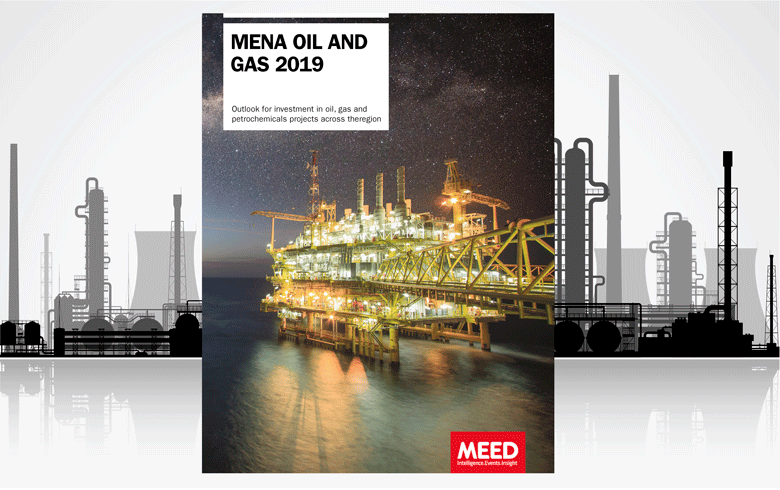

| Click here to find out more about the report |
Hosting more than 50 per cent of global crude oil reserves and 45 per cent of gas deposits, the Middle East and North Africa (Mena) region is home to the world’s biggest oil, gas and petrochemicals projects spenders.
More than $443bn-worth of major oil, gas and petrochemicals project contracts have been awarded in the region since 2007, an average of $40.3bn a year.
In terms of individual countries, Iran, Saudi Arabia and the UAE have the biggest pipelines of projects with $103bn, $58bn and $50bn of planned but unawarded projects, respectively.
At the end of 2018, there were about $664bn-worth of oil, gas and petrochemicals projects planned or underway across the Mena region, and an estimated $396bn-worth of projects planned or unawarded. About $41bn of oil, gas and petrochemicals project contracts were awarded in the Mena region last year, down 32 per cent on the $59.1bn awarded in 2017.
Changing market
With a pipeline of about $396bn of future projects planned across the region, there are plenty more opportunities to look forward to.
But the market is changing. And everyone involved in Middle East oil and gas must be ready to change with it.
Previous spending has been driven by decades of strong growth in demand for energy that in 2019 is likely to push demand for oil above 100 million barrels a day (b/d) for the first time.
However, the long-term outlook for world oil demand is converging on a new consensus that demand will peak somewhere around 2030 to 2040, after which it will start to fall.
For the region’s oil producers, the idea of declining oil demand represents a major challenge to their traditional economic model, which depends heavily on crude exports. In response, they are turning their focus downstream. The challenge for oil companies is to squeeze as much value out of each drop of oil to produce more high-value fuels, speciality petrochemicals and industrial feedstocks. The aim is not only to maximise revenues, but also to develop new technologies and expertise.
Plans are already in place for a massive investment in the downstream sector, with more than $200bn expected to be ploughed into new refining and petrochemicals ventures in the GCC by 2025.
Abu Dhabi is leading the way in the newest investment wave, outlining plans in May last year for a $45bn expansion of its Ruwais refinery complex. Saudi Aramco, meanwhile, has tied up with France’s Total to expand its Satorp refining and petrochemicals joint venture, and also with Saudi Basic Industries Corporation (Sabic) to develop a new 400,000 b/d crude-to-chemicals facility.
This direct processing route may even challenge the current model of integration from upstream to refining and then petrochemicals. Kuwait and Oman have similar schemes underway to integrate their complexes and diversify production.
Meanwhile, the global oil price slump has led to Opec members agreeing to cut production to minimise inventories and rebalance crude prices. As a result, producers in the GCC reduced their oil production during 2017 and continued the same in the first half of 2018.
Pressing priorities
Boosting natural gas supplies and production capacity has become a priority for regional governments, as they aim to meet domestic demand, which has grown by up to 15 per cent annually, led by the power and industrial sectors.
The employment of local nationals has also become an important issue for foreign engineering firms and contractors in Oman, the UAE and Saudi Arabia as governments seek to stimulate national employment in the oil and gas sector.
Saudi Aramco signed agreements with local and foreign firms worth a reported total of $10.4bn as part of its In-Kingdom Total Value Add programme, while the UAE’s Abu Dhabi National Oil Company (Adnoc) started implementing its own in-country value programme from 1 January 2018.
About the report
 Mena Oil and Gas Market 2019 examines the outlook for policy and investment in oil, gas and petrochemicals projects across the Mena region. The report is useful for anyone seeking to identify opportunities, understand risks and set strategy in the regional oil and gas projects market. Click here to find out more
Mena Oil and Gas Market 2019 examines the outlook for policy and investment in oil, gas and petrochemicals projects across the Mena region. The report is useful for anyone seeking to identify opportunities, understand risks and set strategy in the regional oil and gas projects market. Click here to find out more
You might also like...

Hassan Allam and Siemens confirm Hafeet Rail award
24 April 2024

UAE builds its downstream and chemical sectors
24 April 2024

Acwa Power eyes selective asset sales
24 April 2024

Bahrain mall to install solar carport
24 April 2024
A MEED Subscription...
Subscribe or upgrade your current MEED.com package to support your strategic planning with the MENA region’s best source of business information. Proceed to our online shop below to find out more about the features in each package.





